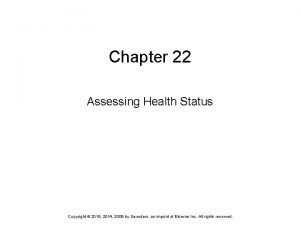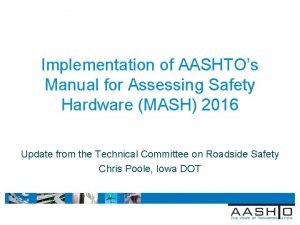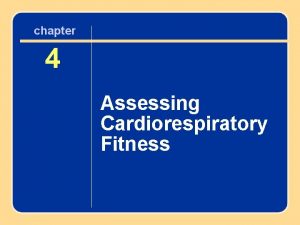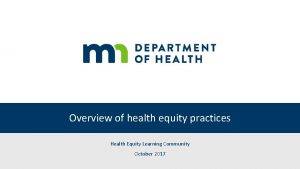Using health equity approaches for assessing equity in














- Slides: 14

Using health equity approaches for assessing equity in maternal and child health care in Thailand Phusit Prakongsai Kanjana Tisayaticom Sudarat Tuntivivat International Health Policy Program (IHPP), Ministry of Public Health, Thailand The 3 rd Global Forum on Gender Statistics 11 -13 October 2010 Manila, Philippines ESA/STAT/AC. 219/35

• • • Outline of presentation Rationale of health equity approach Data availability in Thailand Concentration curve and concentration index (CI) Examples of assessing health equity in selected Maternal and Child Health (MCH) indicators in Thailand Discussion and conclusions The way forward 2

Monitoring & Evaluation of health systems reform /strengthening A general framework Inputs & processes Financing Indicator domains Governance Infrastructure / ICT Health workforce Supply chain Information Data sources Administrative sources Financial tracking system; NHA Databases and records: HR, infrastructure, medicines etc. Policy data Outputs Outcomes Impact Intervention access & services readiness Coverage of interventions Improved health outcomes & equity Prevalence risk behaviours & factors Social and financial risk protection Intervention quality, safety and efficiency Facility assessments Responsiveness Population-based surveys Coverage, health status, equity, risk protection, responsiveness Clinical reporting systems Service readiness, quality, coverage, health status Vital registration Analysis & synthesis Data quality assessment; Estimates and projections; In-depth studies; Use of research results; Assessment of progress and performance of health systems Communication 3 & use Targeted and comprehensive reporting; Regular country review processes; Global reporting

Rationale • Improving health equity is a key outcome indicator for assessing health system performance of a country WHO framework on health system performance assessment (HSPA) • Determinants of health equity – By gender and sex-disaggregated analysis, – other determinants (socio-economic status, educational level, residential areas, etc. ) • Various dimensions of health equity – – Access to and utilization of health care, health care financing, Health status, Health risk behaviors, etc. • Available MCH data from MICS 2006 in Thailand insertion of household asset variables for computing ‘wealth index’ 4

Dimensions and Determinants of Health Equity Healthcare Health Quality & utilization financing responsiveness Health status Government Health subsidy on risk health behavior Demographic Gender Age group Geographic Region Urban vs. Rural Social Education Occupation Economic Income Wealth index 5

Data availability for M&E system in Thailand (1) Input HCF HRH Infra struct ure Gov er nan ce Output Med/ Healt h tech HIS acc ess qual ity safet y Outcome effic ienc y Interve n coverag e Impact Risk factor s Civil registration and vital statistics Biennial SES Census / SPC NHES MICS Reproductive H survey Res po nsi ve Equit y Finan prote ct ion Biennial HWS NHA H outco me Note: SES = household socio-economic survey, HWS= Health and Welfare survey, NHES = National Health Examination survey, MICS = Multiple Indicator Cluster survey, NHA = National Health Accounts, HA = Hospital accreditation, SPC= Survey of Population 6 Changes

Data availability for M&E system in Thailand (2) Input HCF Facility-based report H resource survey HRH Infra structu re Gove r nanc e Output Med/ Health tech HIS acc ess Outcome quali ty safet y effici ency Interven coverage Impact Risk factors Res pon sive Equity Finan protect ion HIS electronic IP database Dis surveillance Behavioral H survey Sero-sentinel Survey Specific dis registration Quality assurance (HA) H outco me 7

The concentration curve • The concentration curve graphs on the x-axis the cumulative percentage of the sample ranked by living standards, beginning with the poorest, and on the y-axis the cumulative percentage of the health service use corresponding to each cumulative percentage of the distribution of the living standard variable. 8

The concentration index • is defined as twice the area between the concentration curve and the line of equality (the 45 -degree line running from the bottom-left corner to the top-right). • In the case where there is no income-related inequality, the concentration index is zero. • The index takes a negative value when the concentration curve lies above the 45 -degree line of equality, indicating disproportionate concentration of health service use or other health variables among the poor, and a positive value when it lies below the 45 -degree line of equality. • The index is bounded between -1 and +1 9

Selected concentration curves of ambulatory service use among different types of health facilities in 2003 10

Concentration curves of selected MCH indicators in Thailand, MICS data 2005 -2006 11

Selected MCH indicators in Thailand from MICS data 2005 -2006 Average prevalence or coverage (%) RR between Concentration urban and rural Q 5: Q 1 index Teenage pregnancy 37. 3 0. 76*** 0. 51*** -0. 1073 Family planning 72. 6 0. 92*** 0. 99*** -0. 0005 Prenatal care by skilled health workers 97. 8 1. 0006** 1. 05*** 0. 0078 Low birth weight 8. 3 1. 15*** 0. 92*** 0. 0367 Underweight children 9. 3 0. 52*** 0. 24*** -0. 2192 Stunting 11. 9 0. 66*** 0. 34*** -0. 1767 12

Discussion and conclusion • Most MCH services in Thailand are concentrated to the poor. • Major challenges remain in connection with health outcomes, particularly teenage pregnancy and child malnourishment. • Remaining gaps between the rich and the poor, and between urban and rural areas require policy interventions and multi-sectoral actions. • This analytical approach shows possibility in using health inequity intra- and inter-groups for gender-based analysis. 13

The way forward • Including sex-aggregated and gender-based analyses in health-related M& E system • Intra- and inter-group analyses in other dimensions of health equity e. g. health status, health risk behavior, disease burden, etc. • Dissemination of key research findings and policy communication of gender-based health equity analysis • Establishment of Health Equity Monitoring Network (HEM -Net) for domestic and international networks. 14
 Assessing health status chapter 22
Assessing health status chapter 22 What are the 5 approaches to health promotion
What are the 5 approaches to health promotion Public health approaches
Public health approaches Assessing risk in sport
Assessing risk in sport Unit 18 assessing children's development support needs
Unit 18 assessing children's development support needs Assessing grammar effectively
Assessing grammar effectively Career stages of ppst
Career stages of ppst Assessing need for hrd
Assessing need for hrd Iri reading assessment
Iri reading assessment Aashto manual for assessing safety hardware
Aashto manual for assessing safety hardware Cultural dynamics in assessing global markets
Cultural dynamics in assessing global markets Assessing a new venture's financial strength and viability
Assessing a new venture's financial strength and viability Assessing cardiorespiratory fitness
Assessing cardiorespiratory fitness Assessing leadership and measuring its effects
Assessing leadership and measuring its effects Module 4 topic 5 turnabouts and parking
Module 4 topic 5 turnabouts and parking



























